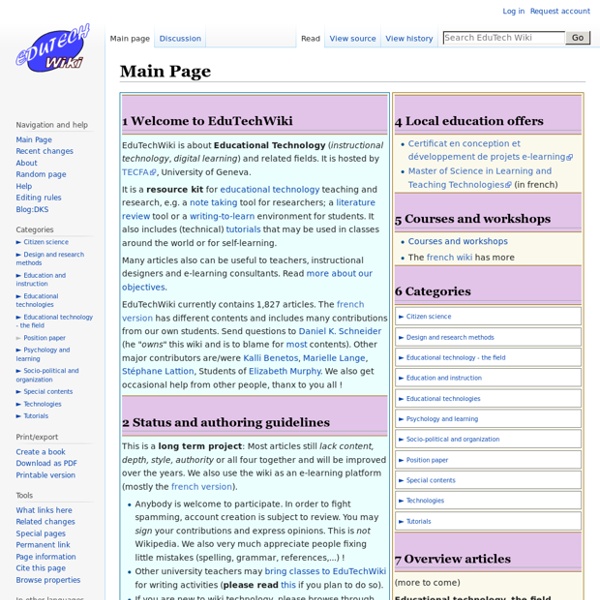Instructional Design Models
Instructional Design Models Models, like myths and metaphors, help us to make sense of our world. Whether derived from whim or from serious research, a model offers its user a means of comprehending an otherwise incomprehensible problem. An instructional design model gives structure and meaning to an I.D. problem, enabling the would-be designer to negotiate her design task with a semblance of conscious understanding. Models help us to visualize the problem, to break it down into discrete, manageable units.
100 Blogs That Will Make You Smarter
By Alisa Miller Reading blogs doesn’t have to be an exercise in futility or a waste of time. Your blog addiction can serve you well by with these blogs that are sure to make you smarter. These blogs bring you information about politics, education, technology, art, literature, an international perspective on life and culture, and much more.
Wikis in Education: How Wikis are Being Used in the Classroom
Share on StumbleUpon0 shares on StumbleUpon Courses & Certification Instructional Design Certificate (Fully Online). This fully online program is for anyone developing and/or teaching an online course. Learn more... ADDIE Instructional Design Certificate Program (Fully Online). This fully online program is designed for individuals interested in learning more about the ADDIE model.
IDKB - Models/Theories
Learning happens when a correct response is demonstrated following the presentation of a specific environmental stimulus Learning can be detected by observing an organism over a period of time Emphasis is on observable and measurable behaviors Uses a "black box" metaphor - the learner is a black box, what happens inside is unknown Emphasis is on relationships between environmental variables and behavior Instruction utilizes consequences and reinforcement of learned behaviors
Collaborative writing software online with Writeboard. Write, share, revise, compare.
Hello, We launched Writeboard back in October of 2005 as a stand-alone service. A few years later we integrated Writeboards into Basecamp Classic and Backpack.
FANDOM powered by Wikia
Technology in education is most simply and comfortably defined as an array of tools that might prove helpful in advancing student learning and may be measured in how and why individuals behave. Educational Technology relies on a broad definition of the word "technology." Technology can refer to material objects of use to humanity, such as machines or hardware, but it can also encompass broader themes, including systems, methods of organization, and techniques. Some modern tools include but are not limited to overhead projectors, laptop computers, and calculators.
Blowing Out the Digital Book as We Know It
Culture Digital Tools Teaching Strategies Inkling “There is no future of the digital book — not the way we envision it today,” said Matt MacInnis, the founder and CEO of Inkling, the San Francisco startup that’s re-conceptualizing books for the digital realm. He’s right. Tablets and e-readers are unraveling the publishing industry as it’s existed until now.
Classifying Objectives
View in Web Browser /instructional/_layouts/VisioWebAccess/VisioWebAccess.aspx?listguid={ListId}&itemid={ItemId}&DefaultItemOpen=1
Ethical EdTech
A collaborative wiki of tools for ethical pedagogy. Why Ethical EdTech? Much of what passes for educational technology is designed for purposes of profit-seeking, surveillance of students, and user lock-in. Other kinds of technology exist, but they typically lack the marketing and sales budgets of competing vendors. This is a directory, created by and for higher-ed educators, for sharing tools and use-cases.



